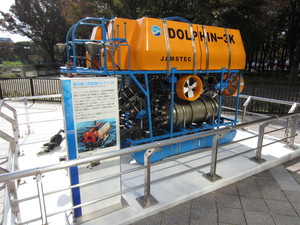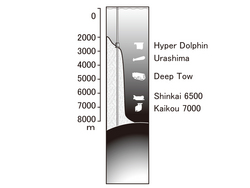Nagoya City Science Museum
TOP > Exhibition Guide > Keyword Search > Starting with "U" > unmanned > Deep Sea Research Vehicle 'Dolphin 3K'
Deep Sea Research Vehicle 'Dolphin 3K'

Purpose of Exhibition
Even outside the Science Museum (exhibition room) there is an exhibit.
This unmanned probe was made in order to study the deep sea.
Its main purpose was to investigate marine resources, marine life, and earthquakes.


Additional Knowledge
[Dolphin 3K]
This exhibit has been planned by the Japan Agency for Marine-Earth Science Technology, the independent administrative institution. It is the Japan's first unmanned probe designed to perform research on seabed minerals and marine life at 3000 m. Although it is equipped with high- definition cameras and manipulators, the system is remotely controlled from a ship on the sea. From 1987 (Showa 62) to 2002 (Heisei 14), it dived 576 times in Japanese water for marine research.
Since 2003(Heisei15), its role has been takentaken over by its successor, the Hyper Dolphin.
[Survey Objectives: Resources, Living Creatures and Earthquakes]
The ocean around Japan is said to be a treasure housetrove of marine resources, methane hydrate, which is frozen methane and natural gas in the East China Sea. Deep sea probes play an important role for the investigation of thosein the investigation of these resources.
Also for the investigation of earthquakes occurring around Japan, the exploration of the seabed is neededExploration of the seabed is also needed in order to investigate earthquakes occurring around Japan.
Besides these practical surveys, looking at actual activities of the deep sea creatures can lead to valuable information on for academic research.
[The Deepest Sea]
In addition to Dolphin 3K and its successor, Hyper Dolphin 3K, there areis a deep-sea probe "Urashima", a manned deep-sea research vessel "Shinkai2000", and an unmanned probe "Kaikou 7000 II". And the depth each probe can dive is specified. (Figure)ThoseThese probes can dive down to a considerable depth. By the way, where is the deepest part of the ocean?Currently, the deepest ocean trench, the thin and long grooved part, is called the Mariana Trench.
In 1960 (Showa 35), in the cooperation with the US Navy, Jacques Piccard and the captain Walsh boarded a submarine developed by Jacques's father, August Piccard, and aimed for the bottom of the Mariana Trench. The submarine was equipped with steel weights and gasoline-fueled buoyancy devices, and was able to adjust depth. According to the depth recorder that reached the seabed in five hours, it was 11521m deep (Later revised as 10916m). In 1995 (Heisei 7), the remotely controlled unmanned submarine "Kaikou", owned by the Japan Agency for Marine-Earth Science Technology, reached the deepest part of the Mariana Trench, called the Challenger Deep, and recorded the a depth of 10911m.
Even Mt. Everest, the highest mountain in the world, turned upside down cannot reach the deepest point of the ocean.
Article by Koichi Mabuchi, curator
